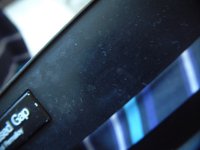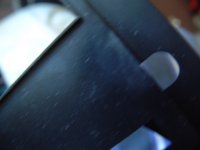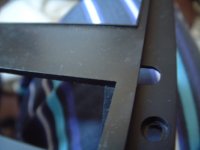hi- i have nak 550- some of the black plastic is cloudy- i know there are many products out there- but i dont know which is best- any info appreciated
Some foam cleaners and such like can often leave a cloudy milky appearance on black surfaces.
Without knowing what has happened to yours it is difficult to say whether it can be recovered but you might surprised that the disposable make up wipes and similar actually clean such surfaces fantastically well. You can try all the usual stuff and it looks awful, try a wipe and it comes genuinely as good as new... if that is what yours is suffering from.
Without knowing what has happened to yours it is difficult to say whether it can be recovered but you might surprised that the disposable make up wipes and similar actually clean such surfaces fantastically well. You can try all the usual stuff and it looks awful, try a wipe and it comes genuinely as good as new... if that is what yours is suffering from.
The usual culprit is sunlight or just old age. Almost all plastics oxidise and the long chain molecules that make them up cross link and the plastic gets brittle or, the chains break down into other compounds and 'dust' or become sticky to the touch.
A cloudy surface is a sign that the polymers have started this process. You could try sanding or polishing to take that cloudy layer off and exposing fresh plastic, but it's a lot of work with no guarantee of success. Not all plastic surfaces are purely one plastic, sometimes they are layers of different materials to combine flexibility with a harder finish that'll take a polish and be durable. You might only need to remove that outer coat. But unless you can find someone who did it successfully, you may just make a bad situation worse.
I don't know of any compounds that'll stop the decay or repair the surface, whatever they do it'll be cosmetic and you always run the risk of more problems later on as they interact with the plastic.
If I were you, I'd leave it alone as long as it's purely cosmetic...
A cloudy surface is a sign that the polymers have started this process. You could try sanding or polishing to take that cloudy layer off and exposing fresh plastic, but it's a lot of work with no guarantee of success. Not all plastic surfaces are purely one plastic, sometimes they are layers of different materials to combine flexibility with a harder finish that'll take a polish and be durable. You might only need to remove that outer coat. But unless you can find someone who did it successfully, you may just make a bad situation worse.
I don't know of any compounds that'll stop the decay or repair the surface, whatever they do it'll be cosmetic and you always run the risk of more problems later on as they interact with the plastic.
If I were you, I'd leave it alone as long as it's purely cosmetic...
Last edited:
Bakelite ( without the later additives ) keeps its color .
I have a large collection of Bakelite/plastic cased radios plus early small portable transistor radios still in good shape so I am afraid I don't agree that they "end up in dust or the color vanishes " .
OTOH plastic carrier bags from supermarkets were intentionally made to deteriorate.
By the way BT ( whom I worked for ) issued "Bakelite Paste " in a tube to polish the surfaces and it just so happens I have several tubes when it was part of the GPO -
Paste Polishing No.5 --item code no.210562 etc all done to "Army style " itemizing.
I have a large collection of Bakelite/plastic cased radios plus early small portable transistor radios still in good shape so I am afraid I don't agree that they "end up in dust or the color vanishes " .
OTOH plastic carrier bags from supermarkets were intentionally made to deteriorate.
By the way BT ( whom I worked for ) issued "Bakelite Paste " in a tube to polish the surfaces and it just so happens I have several tubes when it was part of the GPO -
Paste Polishing No.5 --item code no.210562 etc all done to "Army style " itemizing.
For plastic like on the 550, I’ve used paints like those sold by SEM. They have various finishes available.
Can we see a detail picture of the surface? If a phone camera will not do it, you may have to find a friend with a camera.
I have Naks, incl 550 & 500, so if I have some surface anywhere like yours, I'll play with it.
By the way, I am still enjoying the playlist you did to honor your brother, we still miss him.
Best, David
I have Naks, incl 550 & 500, so if I have some surface anywhere like yours, I'll play with it.
By the way, I am still enjoying the playlist you did to honor your brother, we still miss him.
Best, David
I have use flame from a propane torch to bring back the colour on my tractor steering wheel. I was skeptical at first but once I tried a test area it seemed to work fine. After 5 years it still looks pretty good. Not sure if this idea is appropriate for you but it worked for me.
I hope this helps
I hope this helps
The problem is caused by environmental deterioration.
I have used flame treatment, you have to gently melt the top layer without burning it, it takes experience.
As the owner of a plastic factory, I own a circulating type tray drier, the material is to be kept at HDT less 20 Celsius for 2 hours, generally better results than flame treatment are obtained.
HDT is heat deflection temperature, different for different plastics, not applicable to thermosets like bakelite.
If needed, the paint systems for car bumpers should work, use the procedures as for cars.
The surface has to be cleaned free of loose material, special primer - called surfacer here - is sprayed, and then 2 part car paint sprayed on. The primer is needed, most paints do not stick to plastic without it.
That should last years if done properly.
I have used flame treatment, you have to gently melt the top layer without burning it, it takes experience.
As the owner of a plastic factory, I own a circulating type tray drier, the material is to be kept at HDT less 20 Celsius for 2 hours, generally better results than flame treatment are obtained.
HDT is heat deflection temperature, different for different plastics, not applicable to thermosets like bakelite.
If needed, the paint systems for car bumpers should work, use the procedures as for cars.
The surface has to be cleaned free of loose material, special primer - called surfacer here - is sprayed, and then 2 part car paint sprayed on. The primer is needed, most paints do not stick to plastic without it.
That should last years if done properly.
Bakelite ( without the later additives ) keeps its color .
Strictly, Bakelite is a phenolic resin and while it's a thermosetting plastic it's not the same as plastics commonly in use today.
You could try one of the car bumper sprays.
As with car bumpers, results will depend on how bad the surface is.
Also, should you later decide it really needs painting you would have to remove all residue.
As the saying goes - try an inconspicuous area first.
As with car bumpers, results will depend on how bad the surface is.
Also, should you later decide it really needs painting you would have to remove all residue.
As the saying goes - try an inconspicuous area first.
Give it good wash with liquid soap and a soft cloth.
It looks like dust that has stuck.
Then use a window cleaner with anti static properties, that will keep it from attracting dust.
Anyway before any work it needs to be cleaned.
It looks like dust that has stuck.
Then use a window cleaner with anti static properties, that will keep it from attracting dust.
Anyway before any work it needs to be cleaned.
Techically plastic is short for thermoplastic, so if its thermosetting its not plastic, its a thermosetting polymer. Plastic means deformable, like elastic. Thermosetting polymers are widely used today still, melamine being a prime example you see everywhere.Strictly, Bakelite is a phenolic resin and while it's a thermosetting plastic it's not the same as plastics commonly in use today.
Back to the question - without knowing what sort of black plastic is invoved, its hard to give a safe recommendation. The damage could be sunlight, oxidation, or erroneous use of solvent-based cleaners in the past. Certainly never use anything solvent based on an unknown type of plastic, that could ruin it. mild soap/detergent and water only unless you are sure about the compatibility (for instance even lemon rind can blister polycarbonates.)
Much plastic is ABS, which is a co-polyer of butadiene, styrene and acrylic. Styrene polymers are also extremely sensitive to solvents, so ABS is
likely to be fairly sensitive (the mix of components is specficially to avoid the worst properties of each component and tuning the toughness and
strength)
Last edited:
The world's first fully synthetic plastic was Bakelite, invented in New York in 1907, by Leo Baekeland who coined the term "plastics".
I started my factory in 1993.
I am reputed for doing difficult work, such as optical molding.
Just wash it.
Peanut oil will stink and leave gummy residues as it ages over time, as in a few months' time.
ABS is easy to paint over without "surfacer", so is Noryl.
And yes without any idea of what polymer, it is difficult to suggest any treatment, as within the class (even if marked), the proportions, blends and even process conditions can make it difficult to actually identify the exact polymer grade and blend used.
The class mark is used now, a number inside a recycle triangle, it gives some idea as to what family the plastic belongs to.
But I suggest that you keep it at a place where it is not exposed to direct sun, and a temperature range where humans can comfortably sit, or about 15 to 45 degrees C.
Doing more to old plastic items is difficult.
Thermo means heat
Thermoplastics soften when heat is applied, can flow, and will set after heat is removed.
Thermoset means the material will set when heat is applied, and the article is cooled down. It will not soften when heat is applied again.
So thermosets are less to totally not suited for some common plastic production processes like injection and blow molding and not at all useful for film production.
Hard to recycle, too. So more used for durables like electrical parts, rather than short life consumer stuff.
Anyway, given the relatively new shape, it looks like a thermoplastic material, processed by injection molding.
So keep it clean and bear in mind that many reactions can occur with common house hold chemicals on plastic.
Which is why I suggested a mild cleaner like liquid soap or glass window cleaner, if in doubt try on a less visible area, and always remove the residue...
For example, acetone, or really the active ingredient in nail polish remover, can damage many plastic surfaces, and rubbing (isopropyl) alcohol can disintegrate poly carbonate.
Take care...
I am reputed for doing difficult work, such as optical molding.
Just wash it.
Peanut oil will stink and leave gummy residues as it ages over time, as in a few months' time.
ABS is easy to paint over without "surfacer", so is Noryl.
And yes without any idea of what polymer, it is difficult to suggest any treatment, as within the class (even if marked), the proportions, blends and even process conditions can make it difficult to actually identify the exact polymer grade and blend used.
The class mark is used now, a number inside a recycle triangle, it gives some idea as to what family the plastic belongs to.
But I suggest that you keep it at a place where it is not exposed to direct sun, and a temperature range where humans can comfortably sit, or about 15 to 45 degrees C.
Doing more to old plastic items is difficult.
Thermo means heat
Thermoplastics soften when heat is applied, can flow, and will set after heat is removed.
Thermoset means the material will set when heat is applied, and the article is cooled down. It will not soften when heat is applied again.
So thermosets are less to totally not suited for some common plastic production processes like injection and blow molding and not at all useful for film production.
Hard to recycle, too. So more used for durables like electrical parts, rather than short life consumer stuff.
Anyway, given the relatively new shape, it looks like a thermoplastic material, processed by injection molding.
So keep it clean and bear in mind that many reactions can occur with common house hold chemicals on plastic.
Which is why I suggested a mild cleaner like liquid soap or glass window cleaner, if in doubt try on a less visible area, and always remove the residue...
For example, acetone, or really the active ingredient in nail polish remover, can damage many plastic surfaces, and rubbing (isopropyl) alcohol can disintegrate poly carbonate.
Take care...
Last edited:
Techically plastic is short for thermoplastic, so if its thermosetting its not plastic, its a thermosetting polymer. Plastic means deformable, like elastic. Thermosetting polymers are widely used today still, melamine being a prime example you see everywhere.
You're horrible 🙂 I deliberately tried to avoid going down the is it/isn't it a plastic rabbit hole and look what you did...
I wouldn't argue at all with what you say, but 'reliable sources' like Wikipedia are happy to refer to it (erroneously) as the 'first plastic'. Just. Didn't. Want. To. Go. There.
I have it from multiple sources (pre-dating Wikipedia) that Bakelite was the first fully synthetic plastic.
If this is erroneous, please enlighten me.
If this is erroneous, please enlighten me.
Bakelite First Synthetic Plastic - National Historic Chemical Landmark - American Chemical Society
I remember motor bike sidecar windows were made out of Celluloid -- kept on splitting.
I remember motor bike sidecar windows were made out of Celluloid -- kept on splitting.
- Home
- Source & Line
- Analogue Source
- restoring old black plastic



